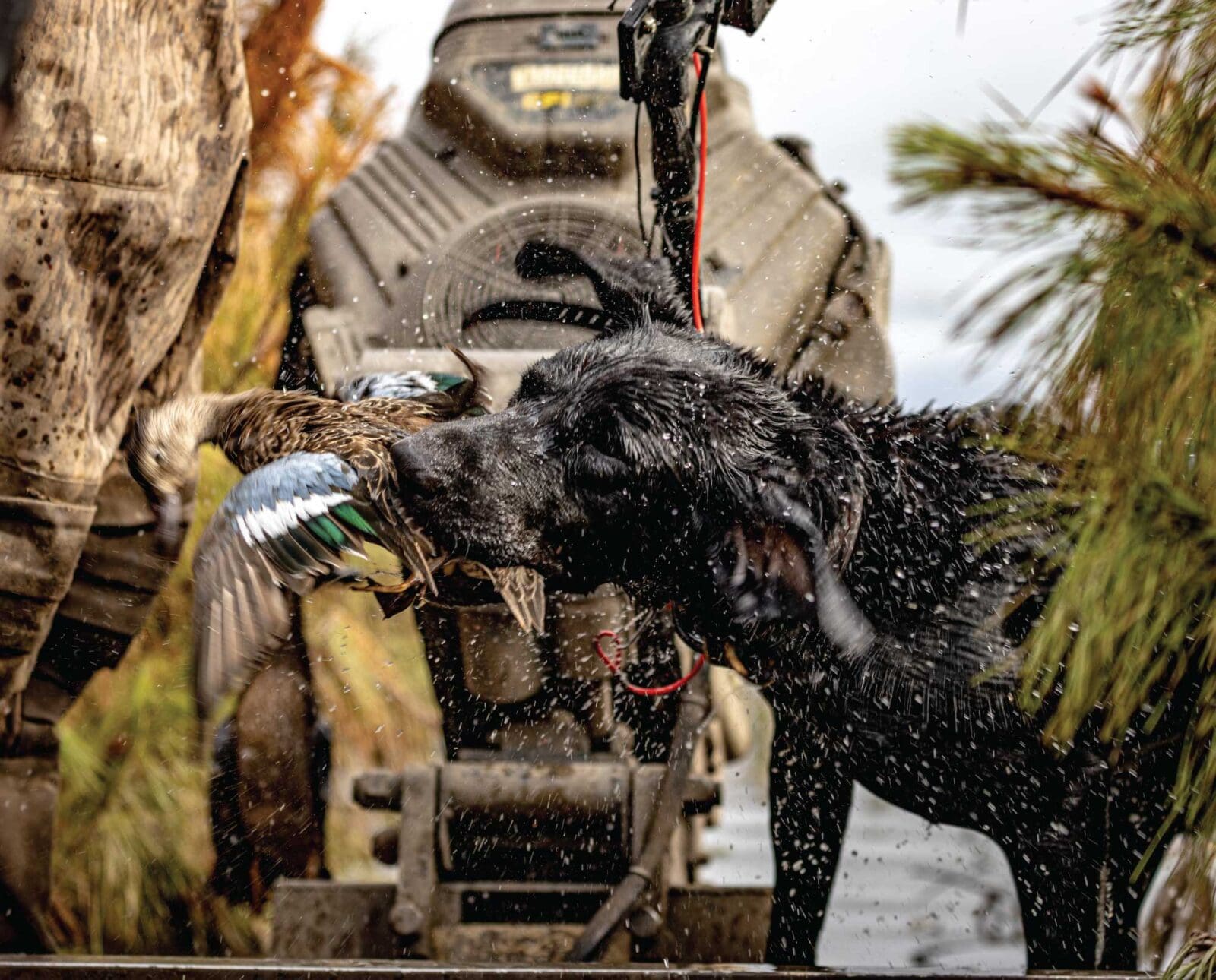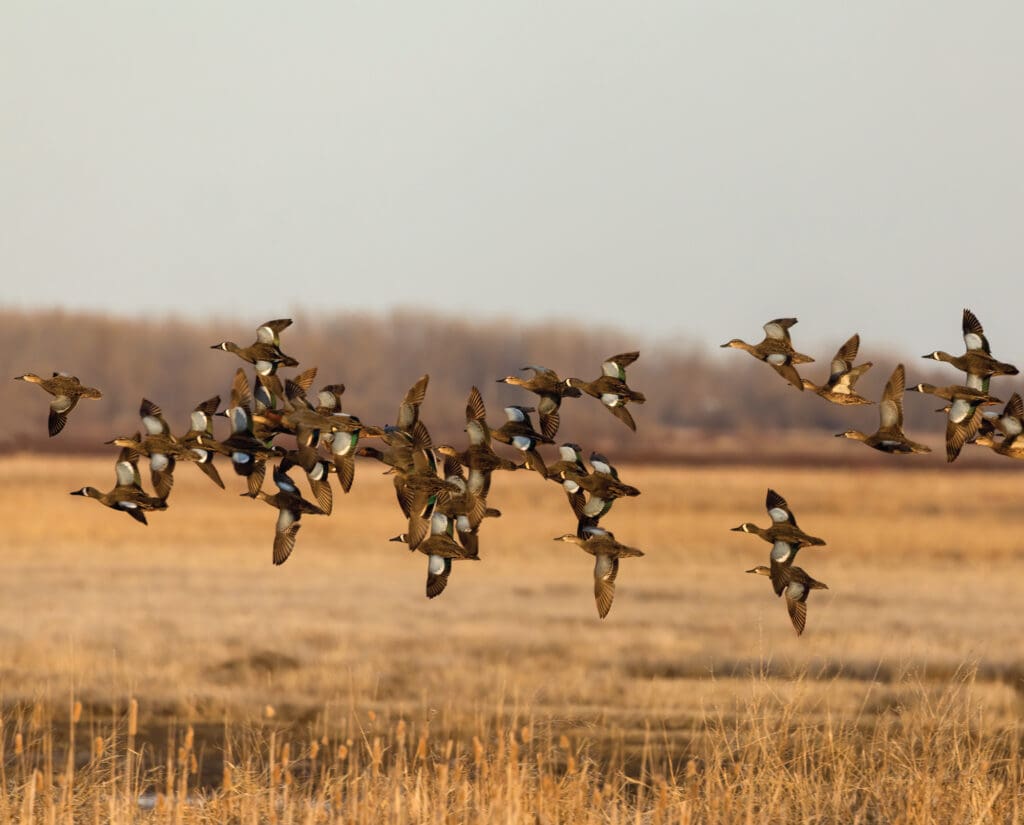Home » Waterfowl Hunting » A Complete Guide to Teal Hunting
A Complete Guide to Teal Hunting

Mike Adams is an outdoor writer, wildlife biologist, and educator…
Everything you need to know about wingshooting, decoying, calling, and hunting early-season teal
If you’re hunting early-season teal, you’d better be quick. These ducks fly like low-altitude missiles. As they buzz over marsh grass, you can hear their wings cut through the air like ricocheting bullets. The sound resembles a revved-up jet engine that crescendos into pure pandemonium as the teal get close. You may have six, 12, or even 50 teal swarming overhead at that point. When that time comes, be fast because if you miss the first shot, the flock scatters into all directions like an exploding firework.
Listen to more articles on Apple | Google | Spotify | Audible
The scene can cause an anxious duck hunter to throw up their gun and fire off a shot in a panic. When they miss, they may throw up their hands and curse off teal altogether. However, if you’ve ever had one on a plate, that won’t be the case. Teal make for some of the finest table fare of any duck. Their sweet, tender meat can convert even the most ardent wild game haters into duck meat lovers. That’s part of the reason why people get hooked on them. On top of that, special teal seasons kick off most state’s waterfowl hunts, providing hunters an early opportunity at some high-caliber action.
Get Familiar with Teal Species
There are three species of teal in North America: the blue-winged teal, the green-winged teal, and the cinnamon teal. Telling them apart is pretty easy because, long ago, someone was smart enough to name them based on their looks.
Male blue-winged teal have just that: a blue wing. The bold patch of metallic blue stands out starkly against their mottled brown chest. A band of white plumage resembling a crescent moon lines the front of their face behind the bill. On the other hand, green-wings have a chestnut-colored head and a green eye patch that drips down the back of their neck. They have slate gray bodies like a wigeon and lime-green speculum feathers. Cinnamon teal have blue coverts, just like blue-winged teal, but the rest of their body is steeped in a crimson red. The color looks just like cinnamon.
Cinnamon teal are relegated to far western America, while the other two species blanket the country. Some years, it feels like you’ve hardly had enough time to patch your waders before the teal arrive. The blues get here before the greens. Blues can appear in parts of the mid-Atlantic as early as July; by August, they cover the Lower 48. Greens follow a migration pattern similar to most other ducks, showing up from the north by September and departing by mid-spring.

Wingshooting Teal: Shotgun Chokes, Shot Sizes, and Shooting Tips
Wingshooting teal is an art. It requires careful consideration, quick thinking, and deliberate movements. Earlier, I mentioned that when teal buzz low on a marsh creek, they sound like football-sized jet engines. That’s the sound that gets most hunters’ blood boiling. Their heart thrusts through their chest in anticipation, and their cold hands are shaky. Shaky hands and arhythmic hearts make for sloppy aiming, and missiling teal never forgive a poor shot.
Hunters need to break down their shots to get good at shooting teal on the wing. It begins with smooth movements. Pulling off a jerk-and-click shot with most ducks is tempting, but that shooting style won’t pan out for teal. Unlike fat-bodied mallards that stool in like they’re on a zipline, teal bounce around like ping pong balls. Their flight patterns can be erratic. At times, they can seem impossible to react to.
Teal hunters benefit from smooth transitions. From shouldering the gun to finding the bead to finding the bird, the movements should be delicate and precise. This keeps your concentration and nerves in check. Trace a teal as it flies in the air and aim for the tip of the bill. Fast-moving teal require a fair bit of lead, but they’re also small and usually closer than you think. Shooting for the tip of the bill often gives you all the runway you need for a kill, as long as you follow through. Improved cylinder shotgun chokes work well for most shots on teal. Use shot loads packed with No. 4, 5, or 6 steel shot to avoid obliterating their meat.
Scouting for Teal Season
Finding teal honeyholes boils down to finding high-quality habitat. Down south, it’s rice fields. Out west, it’s corn fields, and in the marshes of the mid-Atlantic, it’s creek bends.
For teal, high-quality habitat equates to shallow water with lots of food. Cold temperatures drive a small-bodied teal into metabolic overdrive. To get the energy they need to survive the winter season, teal concentrate on calorically dense foods stuffed with essential proteins and fat. In aquatic environments, that comes in the form of weeds, seeds, and snails.
Flooded areas with pondweeds, bulrushes, smartweeds, duckweeds, and wild rice are good places to hunt. Similarly, flooded ag fields perform as teal magnets. Rice, corn, and soybean fields are some of their favorites.
Water depth contributes significantly to teal habitat. Anything over a foot in depth can only serve as a teal loafing area. When these petite birds flip upside down to feed underneath the water’s surface, they typically only reach a little over 6” in depth. Search for flooded mudflats along creek bends, marsh points, and the edges of large water bodies. These areas will likely have a mix of favorable aquatic vegetation and tasty invertebrates.
Teal Hunting Decoy Spreads
There’s no such thing as a lonely teal. These birds fly around in posses. They feed in cliques at night, hogging up creek bends and making a ruckus like the waterfowl equivalent of the cool kids’ table in a high school cafeteria. By mid-day, they loaf around in envoys, and their crew usually consists of six to 50 birds in a flock.
Teal decoy spreads need to emulate their gregarious behavior. While in some instances it pays off to throw out three spinning wing decoys and six dozen duck decoys of mixed species, that kind of fanciful display will fall short during early teal season. Instead, focus on making the decoy presentation natural.
Effective teal spreads usually contain no other species. When teal cruise around in the predawn dark, they’re looking for small silhouettes to land with, not jumbo-sized mallards. A good presentation may include as many as two dozen decoys or as few as a half dozen in a smaller water body. It’s tempting to overdo it, but small decoy spreads work wonders on teal. These setups hijack their social behavior. Passersby can’t help but crash a small party once they see one. Similarly, teal have no concept of personal bubbles. On the water, they jam in tight to each other. Compact decoy spreads capture teal attention far more than spacious setups.
Master Calling in Teal Before the Season Starts
Wailing on a mallard call while hunting over a teal spread makes as much sense as trying to speak English to a fish. It just doesn’t work. Instead, hardcore teal hunters master the teal language.
Teal calls look like your typical duck call, but they make a far different sound. These calls emulate the cry of hen teal. It sounds like a regular mallard hen call, just higher pitched, raspier, and choppier in cadence. If you know how to use a regular duck call, learning the teal call isn’t too hard.
The two trickiest parts are dealing with the increased back pressure required to break the teal call’s reeds and matching the hastened call cadence. The best way to get better at teal calling is to find some real live birds. This can be done by heading out to the local marsh pond or searching for them on YouTube. Listen to their calls, play it back, try to emulate the sound with your call, and repeat until you have it right.
A duck whistle should hang from your lanyard right next to your hen teal call. These whistles usually serve multiple functions and can sound like a drake mallard, a wigeon, a pintail, or a drake teal. This call is the easiest to master – it’s just a single note. Use a combination of drake whistles and hen cries to bring your decoy spread to life.
Try these tips when you head out for early-season teal this year. Practice your wingshooting and calling, identify suitable teal habitat, and set up your decoy spreads to emulate natural teal spreads. When being in the right place at the right time and accurate, well-lead shots finally come together, your taste buds will thank you.
Mike Adams is an outdoor writer, wildlife biologist, and educator hailing from salt marshes of the mid-Atlantic. His work has appeared in numerous outdoor publications, where he uses hunting and fishing narratives to explore deeper issues in conservation or ecology. In the fall, you'll find him on his Barnegat Bay Sneakbox hunting ducks with his dog, Boone. Any other time of year, he's usually out on the salt marsh, catching crabs or fishing for striper.




